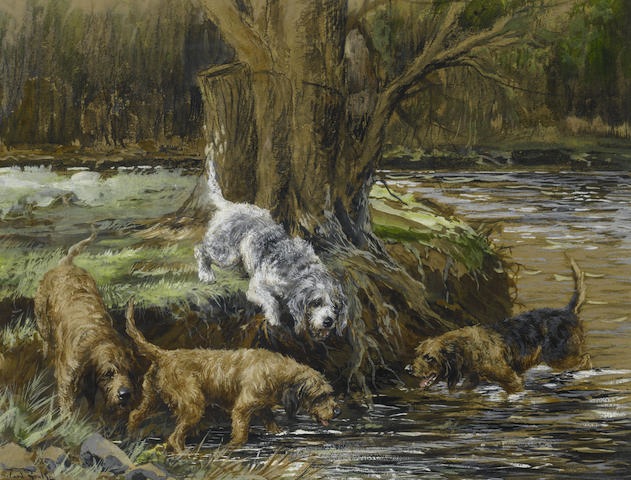
The modern form of the Otterhound most likely took shape late in the 18th century, but there is little doubt that “otter dogges” in England date back to the 12th century when the first record of otter hunting was recorded during the reign of Henry II. Though we find Otters charming today, they were considered vermin in Henry’s time because they competed with fishermen for the natural trout supply in rivers and lakes, and devastated fishponds, an important source of food stocks especially around monasteries. Only later would the animal be hunted for sport, and because it was the only hunting available from March through October, it became very popular with the English gentry. It’s said that there were sometimes over a dozen Otterhound packs in Britain during every hunting season in the late 1800’s. Some of the famous packs of the 19th century were shown at early dog shows (the first recorded being at Leeds in 1861. Eventually, in 1910, the Association of Masters of Otterhounds was formed, and hounds were only shown on the flags at their show at Rugby. Otter hunting reached its peak of popularity in the years just before World War I when there were more than 500 hounds in 24 packs (thought it’s possible that not all of them were purebred Otterhounds.
Where did the breed originate?
King John of Magna Carta fame hunted otter with large shaggy dogs, described at that time as a “rough sort of a dog, between a hound and a terrier,” and the precise ancestry of the breed will likely never be known with certainly. There are two schools of thought about the breed’s origins: An early writer, Marples, stated that the Otterhound was almost the exact duplicate of the Vendeen Hound of France, both alike in both coat and body formation. Others maintain that a combination of breeds were the foundation of the true Otterhound, among them the now extinct Old Southern Hound, the Bloodhound, the Griffon Nivernais from France, the rough coated Welsh Harrier or Foxhound, Griffon de Bresse, Griffon Vendeen, Bulldog and even the wolf.
In 1978, otter hunting was banned in England, and the breed fell on hard times. The Masters of the two remaining, purebred, Otterhound packs, The Dumfriesshire, and The Kendal & District, joined forces with respected breeders in the UK to save a wonderful breed from extinction.
Otterhounds first appeared in America around 1900, and their bench-show debut came at an AKC show in 1907 in Claremont, Oklahoma when six were exhibited. AKC recognition came in 1909, and the breed’s first AKC champions came in 1941. The Otterhound Club of America was founded in 1960, and the first Otterhound National Specialty occurred in 1981.
We are in vehement disagreement with proponents of a school of thought that regards a breed without a purpose as not worth saving. Otterhounds have fabulous noses that can track or man or trace drugs. In fact, the breed has a sense of smell so acute as to be legendary: It can smell in the morning an otter that passed through water the night before. Otterhounds are wonderful companions, but they are also a breed in trouble. We’re read that there are fewer than 1,000 Otterhounds world wide, with an estimate of around 350 Otterhounds in the US and Canada.
“Two Otterhounds Working at the Base of a Tree,” by Reuben Ward Binks (British, 1880–1950)

Otterhounds are truly amazing hounds and make fabulous pets and companions Everyone who owns an Orrerhound is passionate about what they bring to the family
We confess to having a weakness for the breed, David. That irresistible face and wonderful demeanor make us truly puzzled by why this breed is struggling in numbers in the UK….
The reason the breed is struggling is that the gene-pool is so small, coming only from two packs!
Thanks for the insight, Helen!